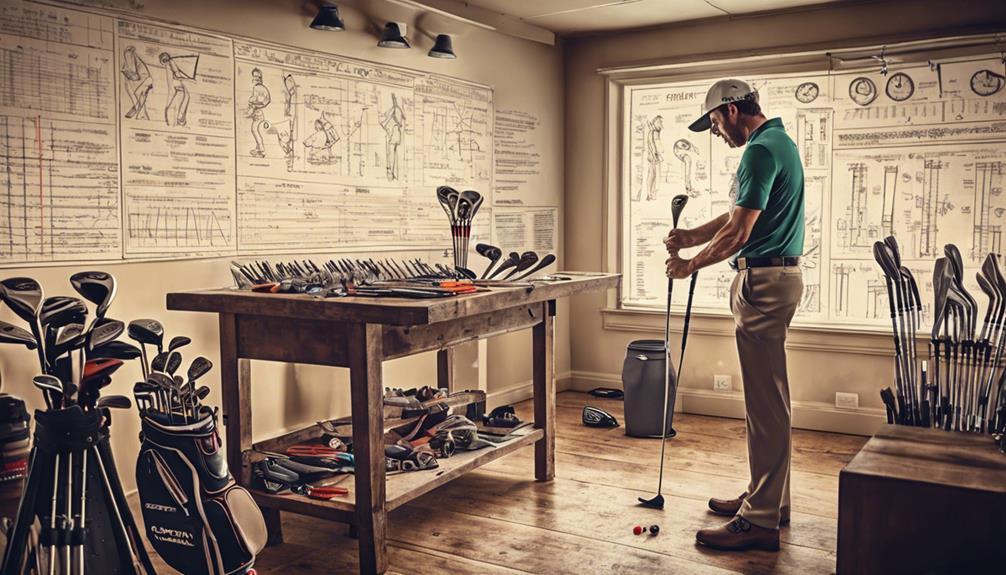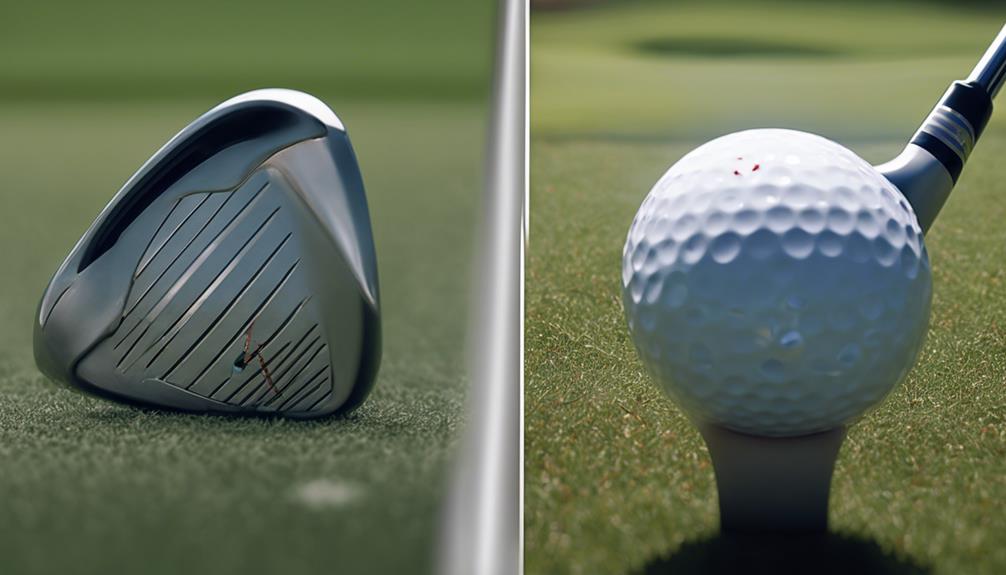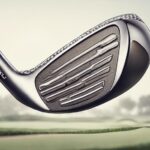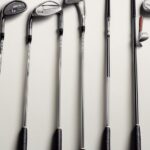- 7 Top Flite Golf Clubs XL for Improved Performance - September 28, 2024
- Top Flite Golf Clubs: Top 5 Reasons to Choose Them - September 28, 2024
- Top 3 Golf Club Fitters for a Perfect Swing - September 28, 2024
You're about to discover the exact degree adjustments that can transform your golf game, as small tweaks to loft and lie can greatly impact ball travel distance, with a mere 1-degree change affecting yardage by 2-4 yards. Understanding loft and lie interactions is essential, as strategic adjustments can improve shot consistency. Customizing club fit eliminates yardage gaps, and exact loft modifications guarantee a precise fit for consistent results. With bending machines offering varying levels of precision, you'll need to master club bending techniques to optimize your game – and it's time to explore the precise bending degrees that'll take your shots to the next level.
Key Takeaways
- Multiple bends are possible without adverse effects, but changes to loft and lie are generally permanent.
- Loft angle changes result in 2-4 yard variations in yardage per degree, significantly affecting ball travel distance.
- Iron lies can be bent beyond 2 degrees, but some metal woods have bending limitations, requiring careful consideration.
- Precise loft and lie adjustments can improve shot consistency, and understanding their interaction is crucial for optimal results.
- Accurate bending machines, such as the Mitchell Angle Machine, are essential for precise adjustments, ensuring optimal club performance.
Club Bending Limitations Explained
When bending your golf clubs, it's crucial to understand that while multiple bends are possible without adverse effects, changes to loft and lie are generally permanent. This means you need to be precise when adjusting your lie angles, as you can't simply revert to the original specifications. When you bend your irons, you're making a commitment to the new configuration.
Fortunately, most clubs can withstand multiple bends, and you can make adjustments to the lie without compromising the club's integrity. However, it's vital to practice on old irons to master bending lies over 2 degrees. You'll find that iron lies can be bent beyond 2 degrees, and long hosel clubs can often be bent further without issue. But don't assume you can bend any club to extreme angles – some metal woods, like stainless steel and forged titanium models, have limitations.
To truly master club bending, consider hands-on training from experts like Mitchell Golf, who offer courses on club repair, building, and alteration. With the right skills and knowledge, you'll be able to customize your metal woods with long hosels and optimize your game.
Impact of Loft Changes on Distance
As you adjust the loft of your golf club, you're directly impacting the distance it travels. Every degree change affects the yardage, and understanding this relationship is key to optimizing your club's performance.
Loft Degree Impacts
By adjusting the loft angle of your golf club, you can expect a noticeable impact on distance, with each degree of change translating to a 2-4 yard variation in yardage. This means that even small tweaks to your club's loft can significantly affect the distance your ball travels.
Understanding the relationship between loft and distance is essential for fine-tuning your club's performance and achieving consistent yardage intervals.
When changing the loft, you'll need to take into account the interaction between loft and lie. A slight adjustment to the loft can alter the club's overall trajectory, which in turn affects the distance it covers.
By calculating the degree equivalents for yardage gaps, you can assess the impact of loft modification on your gameplay. Properly spaced clubs based on degree gaps can enhance distance control and overall performance.
Distance Gaps Formed
You'll find that even slight changes to your club's loft degree can create significant distance gaps between clubs, making it important to understand how these adjustments impact your gameplay.
A one-degree alteration in loft can result in a 2-4 yard difference in distance, which may not seem like much, but these changes can add up quickly. As you fine-tune your club distances, understanding the impact of loft changes is critical for achieving consistent yardage intervals.
By calculating the degree equivalents for yardage gaps (approximately 3 yards per degree), you can better assess the impact of loft adjustments on your game.
When addressing significant distance gaps, strategic loft adjustments can lead to improved shot consistency and overall performance.
For instance, if you notice a 10-yard gap between your 7-iron and 8-iron, adjusting the loft of one or both clubs can help bridge that gap.
Yardage Intervals Affected
When fine-tuning your club distances, a one-degree loft change can greatly impact your yardage intervals, resulting in a 2-4 yard difference that adds up quickly across your set. This means that adjusting the loft on your clubs can have a significant effect on the distances between each club, which is essential for achieving consistent yardage gaps.
For instance, if you strengthen your 7-iron by one degree, you'll likely see a 2-4 yard increase in distance. This, in turn, affects the yardage interval between your 7-iron and 6-iron, and so on.
To optimize your club performance, you need to understand how loft changes impact launch angle and distance. By calculating the degree equivalents for your desired yardage gaps, you can assess the effect of loft adjustments on distance.
For example, if you want a 10-yard gap between your 7-iron and 6-iron, you may need to weaken your 6-iron by half a degree to achieve that gap. By mastering the art of loft adjustments, you can fine-tune your club distances and improve your overall game.
Customizing Club Fit for Consistency

Customizing your club fit is crucial for achieving consistent yardage intervals between clubs, as it directly impacts your overall performance on the course.
To achieve this, make sure to pay attention to the lie angle of your clubs. If the lie is too flat or too upright, it can affect the ball's trajectory and overall distance. To correct this, you may need to bend the lie to guarantee it's perfectly suited to your swing. This precision adjustment can lead to more consistent distances and improved shot shaping.
By customizing your club fit, you can eliminate significant yardage gaps between clubs, resulting in more accurate distance control and overall consistency. Remember, properly spaced clubs based on degree gaps are key to enhancing shot consistency and overall gameplay.
Understanding Loft and Lie Adjustments
By understanding the complexities of loft and lie adjustments, golfers can reveal the full capacity of their clubs, guaranteeing a more precise fit that produces consistent results.
When it comes to loft adjustments, comprehending their impact on distance is vital. You'll notice that a single degree of loft adjustment can impact distance by 2-4 yards, making it essential to fine-tune your clubs for peak performance. To achieve this, you need to calculate degree equivalents for yardage gaps, which will allow you to make precise loft modifications. This is especially important when addressing significant yardage gaps between clubs, as it will enhance consistency in your game.
In addition to loft adjustments, lie angle modifications also play a crucial role in customizing your club fit. By adjusting the lie angle, you can guarantee that the clubhead is square at impact, resulting in more precise shots.
Effects of Bending on Club Performance

As you explore the effects of bending on club performance, you'll find that precise adjustments can greatly impact your game. It's important to understand how bending affects clubhead registration, as even slight variations can change the loft and lie of your clubs, influencing ball trajectory and distance control.
Next, we'll examine the importance of accurate bending machines and how they guarantee exact adjustments to optimize your club's performance.
Clubhead Registration Importance
When bending a golf club, you must secure proper clubhead registration to maintain accurate loft and lie measurements, as even slight misalignments can greatly impact the club's overall performance. This critical step secures that the club's face is square and horizontal, which is essential for consistent performance post-adjustment. Proper clubhead registration also helps prevent mishaps and secures the desired loft and lie angles are achieved.
To illustrate the importance of clubhead registration, consider the following table:
| Registration | Effect on Loft | Effect on Lie |
|---|---|---|
| Proper | Maintains accurate loft | Maintains accurate lie angle |
| Inaccurate | Affects ball flight and distance | Impacts shot consistency and direction |
| Poor | Results in inconsistent performance | Leads to unpredictable results |
| None | Unreliable club performance | Unstable clubhead positioning |
Loft and Lie Impact
Your club's performance is greatly influenced by loft and lie adjustments, which can either enhance or hinder your golf game, depending on the accuracy of the bending process. These adjustments can significantly impact the way you're hitting the ball, affecting the ball flight trajectory and overall club performance.
Here are the key effects of loft and lie adjustments on your golf game:
- Optimized ball flight: Proper loft and lie adjustments ensure the ball takes off at the correct angle, resulting in more consistent and predictable distances.
- Improved turf interaction: By adjusting the lie, you can control how the clubhead interacts with the turf, reducing the risk of digging or skipping.
- Enhanced accuracy: Loft and lie adjustments help you achieve more consistent shots, leading to improved accuracy and reduced dispersion.
- Customized performance: By tailoring the loft and lie to your swing, you can achieve more personalized results and optimize your performance.
- Better shot consistency: With the right loft and lie adjustments, you can hit more consistent shots, resulting in more predictable yardage intervals and better overall performance.
Bending Machine Accuracy
You'll need to trust the precision of your bending machine to achieve best loft and lie adjustments, as even slight miscalculations can greatly impact club performance. Inaccurate measurements can lead to subpar results, making it vital to understand the limitations of your bending machine.
| Bending Machine Type | Precision | Limitations |
|---|---|---|
| Fixed Gauge | ±1° | May not account for varying hosel positions |
| Mitchell® Angle Machine | ±0.25° | Adjustable for all hosel positions |
| Custom Machines | ±0.5° | May require additional calibration |
Proper club clamping, face square, and horizontal positioning are essential for ensuring precise measurements during the bending process. Understanding the importance of precise lie angle adjustments will help you achieve ideal club performance. Don't overlook the significance of bending machine precision, as it can make all the difference in your game. By recognizing the limitations of your machine, you can take steps to ensure accurate adjustments, ultimately leading to improved club performance.
Mastering Club Bending for Better Shots
By grasping the nuances of club bending, golfers can access the full potential of their equipment, making subtle adjustments that translate to significant improvements in shot consistency and overall performance.
As you explore further into the world of club bending, you'll discover the importance of precise measurements and adjustments. To master club bending, focus on the following key aspects:
- Optimize your bending bar: Confirm it's calibrated to provide accurate measurements, allowing you to make precise adjustments to your club's loft and lie angles.
- Achieve a correct lie angle: Understand how to adjust the lie to suit your swing style, resulting in more consistent shots and improved distance control.
- Fine-tune for personalized performance: Experiment with different bending techniques to tailor your clubs to your individual playing style, addressing yardage gaps and improving overall accuracy.
- Develop a keen eye for measurement: Accurately measure and record your club's bending degrees to guarantee consistent results and make data-driven adjustments.
- Practice makes perfect: Regularly practice and refine your club bending techniques to develop muscle memory and confidence in your ability to make precise adjustments.
Frequently Asked Questions
How Many Degrees Can You Bend a Golf Club?
When fine-tuning your swing mechanics, you can bend a golf club up to 2 degrees for loft and lie adjustments during custom fitting, but be cautious not to exceed this limit to maintain best impact angle and club integrity.
Does 2 Degrees Upright Make a Difference?
You'll notice a significant difference with a 2-degree upright lie angle adjustment, as it refines your swing mechanics and optimizes club fitting, resulting in improved accuracy and increased distance, with a more consistent ball flight.
Does a 1 Degree Lie Angle Make a Difference?
'Cut to the chase' – a 1 degree lie angle adjustment can greatly impact your swing, requiring a precise adjustment to correct alignment, making it an essential custom fitting consideration for optimizing ball flight and achieving mastery.
How Many Yards Does 1 Degree of Loft Change?
When you adjust the loft by 1 degree, you can expect a 2-4 yard change in distance, depending on your swing dynamics, which is important in finding best loft settings to maximize your performance on the course.
Conclusion
As you fine-tune your game, remember that golf club bending degrees are the unsung heroes behind your consistent shots. Like a conductor orchestrating a symphony, you must master the subtle art of bending to harmonize your clubs with your swing.
By grasping the intricacies of loft and lie adjustments, you'll reveal the full potential of your clubs and take your game to new heights.
With precision bending, you'll be the maestro of the green, crafting shots that are music to the ears of your opponents.




